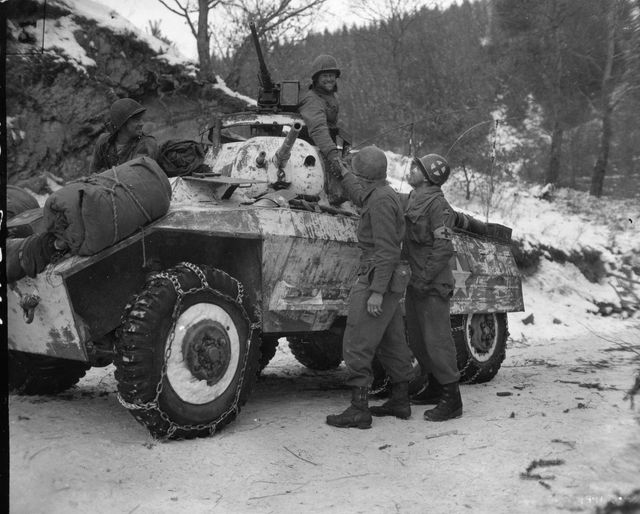78 years before, on January 16, 1945, General George S. Patton’s Third Army elements and General Courtney Hodges’s (Section 2) First Army linked up in the small, battered Belgian town of Houffalize. This action effectively cut the German position in half during what was known as the Battle of the Bulge.
The Germans had launched their campaign one month earlier, attacking through the Ardennes Forest in Belgium and Luxembourg. While Hodges gave ground and fought defensively early in the campaign, Patton drove north and relieved the besieged town of Bastogne on December 26, 1944.
He thought he could liberate Houffalize in a day or two, but it took him more than two weeks to reach the town. Patton sent his 11th Armored Division under Major General Charles Kilburn (Section 7) to capture Houffalize. Meanwhile, Hodges turned his 2nd Armored Division, under Major General Earnest Harmon, south on January 3 to reach the town.
The linkup was made around 9:05 am on January 16, 1945, by Lt. Col. H.M. Foy, the commander of the 11th Armor’s 41st Cavalry Reconnaissance Squadron, and Lt. Col. Hugh O’ Farrell, the commander of the 2nd Armored Division, Task Force A.
The two men immediately recognized each other as Fort Knox’s Armor School classmates. The Bulge was cut in half and would be reduced over the coming weeks. Today, the world honours those who fought and sacrificed their lives so that others could live in freedom.
Through heavy combat at Bastogne, Elsenborn Ridge, and elsewhere in late December 1944, the U.S. Army halted the explosive German offensive that had started the Battle of the Bulge.
As 1945 began, the Army commenced the difficult task of rolling back enemy gains; to this end, General Omar Bradley ordered Lieutenant General George S. Patton Jr. to advance with the U.S. 3rd Army northwards to link up with the U.S. 1st Army led by Lieutenant General Courtney Hodges.
On January 3, the two armies began operations to pinch off the enemy salient and meet at the Belgian town of Houffalize, a vital road nexus about halfway between the similarly critical towns of Bastogne and St. Vith. The U.S. counteroffensive steadily reversed German progress through nearly two weeks of fighting, forcing the enemy out of the deepest part of the Bulge and straightening the Allied line.
The two armies met at Houffalize on January 16, with the 3rd Army’s 11th Infantry Division linking up with the 1st Army’s 2nd Armored Division and repairing the American line; for the remainder of the Battle of the Bulge, German forces would be decisively put on the defensive.



